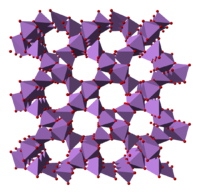Arsenic pentoxide
 |
|
| Names | |
|---|---|
| Other names
Arsenic(V) oxide
Arsenic oxide Arsenic anhydride |
|
| Identifiers | |
|
1303-28-2 |
|
| 3D model (Jmol) | Interactive image |
| ChemSpider |
14088 |
| ECHA InfoCard | 100.013.743 |
| EC Number | 215-116-9 |
| PubChem | 14771 |
| RTECS number | CG2275000 |
|
|
|
|
| Properties | |
| As2O5 | |
| Molar mass | 229.8402 g/mol |
| Appearance | white hygroscopic powder |
| Density | 4.32 g/cm3 |
| Melting point | 315 °C (599 °F; 588 K) (decomposes) |
| 59.5 g/100 mL (0 °C) 65.8 g/100 mL (20 °C) 8.20 g/100 mL (100 °C) |
|
| Solubility | soluble in alcohol |
| Acidity (pKa) | 7 |
| Hazards | |
|
EU classification (DSD)
|
Very toxic (T+) Carc. Cat. 1 Dangerous for the environment (N) |
| R-phrases | R45, R23/25, R50/53 |
| S-phrases | S53, S45, S60, S61 |
| NFPA 704 | |
| Lethal dose or concentration (LD, LC): | |
|
LD50 (median dose)
|
8 mg/kg (rat, oral) |
| US health exposure limits (NIOSH): | |
|
PEL (Permissible)
|
[1910.1018] TWA 0.010 mg/m3 |
|
REL (Recommended)
|
Ca C 0.002 mg/m3 [15-minute] |
|
IDLH (Immediate danger)
|
Ca [5 mg/m3 (as As)] |
| Related compounds | |
|
Other cations
|
Phosphorus pentoxide Antimony pentoxide |
|
Related compounds
|
Arsenic trioxide Arsenic acid |
|
Except where otherwise noted, data are given for materials in their standard state (at 25 °C [77 °F], 100 kPa).
|
|
|
|
|
| Infobox references | |
Arsenic pentoxide is the inorganic compound with the formula As2O5. This glassy, white, deliquescent solid is relatively unstable, consistent with the rarity of the As(V) oxidation state. More common, and far more important commercially, is arsenic(III) oxide (As2O3). All arsenic compounds are highly toxic and thus find only limited commercial applications.
The structure consists of tetrahedral {AsO4} and octahedral {AsO6} centers linked by sharing corners. The structure differs from that of the corresponding phosphorus(V) oxide; as a result, although there is still a solid solution with that oxide, it only progresses to the equimolar point, at which point phosphorus has substituted for arsenic in all of its tetrahedral sites. Likewise, arsenic pentoxide can also dissolve up to an equimolar amount of antimony pentoxide, as antimony substitutes for arsenic only in its octahedral sites.
Paracelsus Macquer found a crystallizable salt which he called ‘sel neutre arsenical’. This salt was the obtaining residue after distilling nitric acid from a mixture of potassium nitrate and arsenic trioxide. Previously Paracelsus heated a mixture of arsenic trioxide and potassium nitrate. He applied the term ‘arsenicum fixum’ to the product. A. Libavius called the same product ‘butyrum arsenici’ (butter of arsenic), although this term was actually used for arsenic tricholoride. The products that Paracelsus and Libavius found were all impure alkali arsenates.Scheele prepared a number of arsenates by the action of arsenic acid on the alkalies. One of the arsenates that he prepared, was arsenic pentoxide. The water in the alkalies evaporated at 180˚C, and the arsenic pentoxide was stable below 400˚C .
Arsenic pentoxide can be crystallized by heating As2O3 under oxygen. This reaction is reversible:
Strong oxidizing agents such as ozone, hydrogen peroxide, and nitric acid convert arsenic trioxide to the pentoxide.
...
Wikipedia

